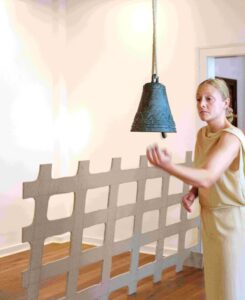Where were you born and raised?
I grew up in Svendborg and Copenhagen respectively. After 14 years in Germany, I now live in Copenhagen again.
Where did you get your education?
I am a trained sculptor and art theorist from the Hochschule für bildende Künste Hamburg and the Academy of Fine Arts in Warsaw. Furthermore, I participated in a postgraduate program in Berlin, where I lived from 2016 until recently. Here, tasks as curator, sculptor for other artists and archaeological excavation assistant shaped my artistic practice.

Documentation of the earthwork KENOTAPH (NORTH) – MAUSOLEUM (MAIOR-MINOR) – QUADRAT (2022); 50 × 4110 × 1140 cm. The test field, Læsø AiR, October 2022. Photo: Per Villumsen/Torben Kjærsgaard Mikkelsen
Why are you now in Denmark?
The decision to return to Denmark has stretched over a long period of time. I've been curious about what it would be like to live here again. Since the German artistic milieu has been my starting point since I was educated, I was nervous. Fortunately, I had the opportunity to take part through a work stay at the Statens Værksteder for Kunst and Læsø AiR last year. In connection with the execution of my latest work, my last hesitation disappeared. It is an earthwork created as a contribution to the archaeological research project Anthropogenic Heathlands, which deals with the formation of the large moorland in Northern Europe. The moorland that emerged after the last Ice Age was cultivated by cattle-herding communities from the beginning of the Bronze Age. The resulting increase in arable farming has precisely formed the (nutritional) basis for the civilizations in which we still live around the world today. On a random Wednesday in March, I traveled from Berlin to West Jutland to meet a shepherd. Apparently she could help me find a heath to expose the earthworks in. I didn't get any permission that day. But before the sun had set, I had promised myself away as a shepherd in West Jutland and then spent the summer in a hut without electricity, surrounded by sheep, burial mounds and inland dunes. On the sixth full moon since I met the shepherd, I was given permission to dig in a patch of heath. It all worked out.![]()
![]()
![]()

Documentation from performance in the exhibition Not a civilization, but you, Kunstverein Göttingen 2022. Photo: Max Sand
How would you describe your artistic practice?
As a sculptor, I work with site-specific installations, drawing, text and sound. I am concerned with, on the basis of linguistic terms, reshaping and presenting selected sacral architectures which have helped form the basis of what we call 'civilisation'. It is important for me to work![]()
![]() with the hands and take as many steps as possible in the execution of the works. I am engrossed in being in contact with sculpture as a phenomenon – and not as a materialized object. It is my motivation to touch on the field of tension that I experience between the sculptural work of contemporary art and the memorials of ancient times. The encounter with this field and the unfolding of its potential in a contemporary context I try to achieve through auditory interactions or by excavating specific forms in the earth's layers and stories. It is my artistic intention to shape monumentality with transience and fragility.
with the hands and take as many steps as possible in the execution of the works. I am engrossed in being in contact with sculpture as a phenomenon – and not as a materialized object. It is my motivation to touch on the field of tension that I experience between the sculptural work of contemporary art and the memorials of ancient times. The encounter with this field and the unfolding of its potential in a contemporary context I try to achieve through auditory interactions or by excavating specific forms in the earth's layers and stories. It is my artistic intention to shape monumentality with transience and fragility.
Why have you joined the Association of Visual Artists?
I have joined BKF to contribute to the organized association that supports our profession in Denmark, and to be able to afford to go to the Hirschsprungske Samling weekly.
Photo at top: Detail of documentation of the earthworks Fure (2023); 50 × 50 × 6000 cm. Part 3 of contribution to 'Anthropogenic Heathlands' (AU/MoMu, DK). Præstbjerg Nature Center, Herning Municipality, September 2023. Photo: Tina Sørensen